
The Surprising Truth About Gen Z & AI
Why College Students Fear Losing Human Connection and Creativity More Than Losing Their Jobs to AI

I recently had the opportunity to give my first university lecture—returning to my alma mater, Cal State Fullerton, to speak on AI Fluency for Entrepreneurs.
Professor Scott Sorrell, also known as “Mr. Charge Higher Prices,” invited me to speak to his MKTG 462 Marketing for Entrepreneurs class.
Standing in front of that room full of business students felt like a full circle moment.
To kick things off, I ran a live poll asking them to rank their biggest concerns about AI’s impact on their careers. I expected “my job becoming obsolete” to dominate the results. After all, that’s what the headlines keep telling us Gen Z should fear, right?
Instead, job obsolescence ranked dead last.
Their number one concern? “Losing human creativity and connection.”
The weighted score wasn’t even close—3.643 for human connection versus 1.786 for job loss. Here was a generation that grew up with technology, currently studying business and entrepreneurship, telling me they weren’t worried about AI taking their jobs. They were worried about AI taking their humanity.
This single data point reframed everything I thought I knew about how college students view AI.
The generation most comfortable with technology isn’t naive about its implications—they’re surprisingly sophisticated in their concerns. And their perspective might be exactly what the rest of us need to hear.
The AI Fluency Gap
I ran the poll at the start of the lecture to establish a baseline before diving into AI fluency concepts. Where did these students see themselves on the AI spectrum?
The self-assessment revealed something interesting: 52% identified as “Regular” users—people who regularly use AI with basic prompting skills. Another 26% called themselves “Explorers,” using AI occasionally for homework or specific tasks. Only one student out of 27 identified as a “Tourist” who’d tried ChatGPT casually.
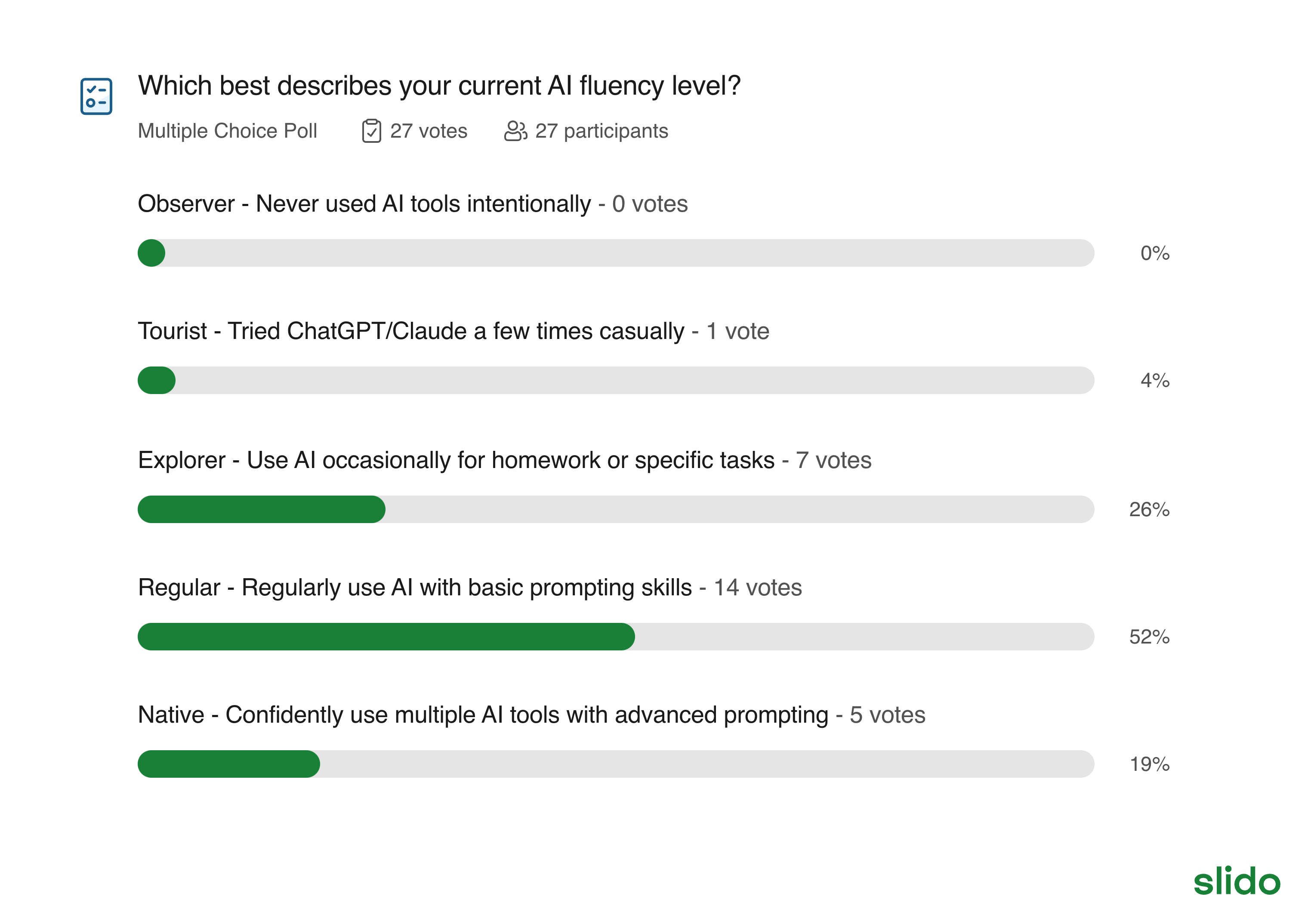
Yet despite this self-reported comfort with AI tools, there’s a massive gap between using AI and understanding its implications.
Here’s the reality check: 96% of companies now prefer candidates with AI experience. This isn’t some future trend—it’s today’s job market.
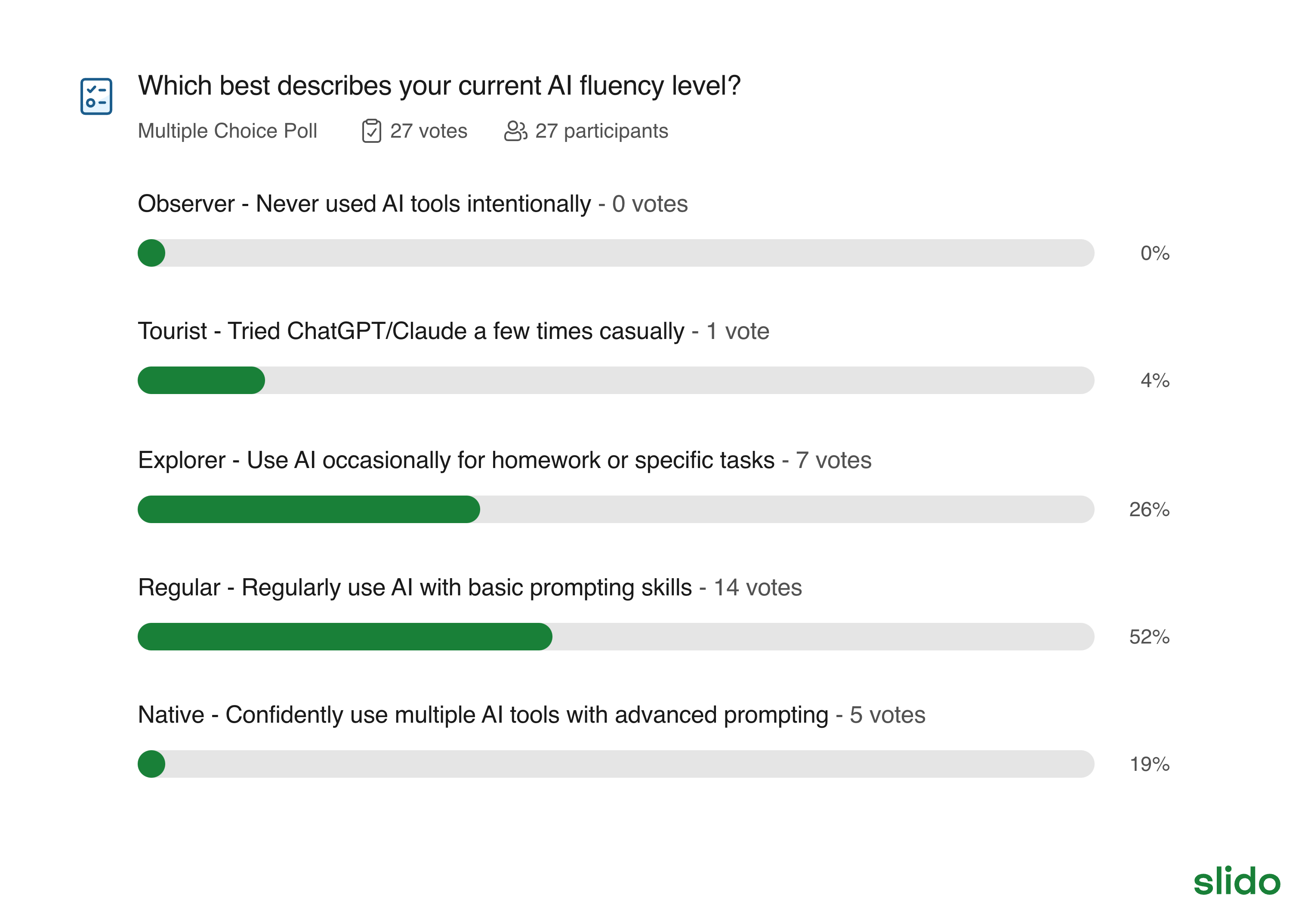
Even more striking, 99% of Americans use AI-enabled products daily, but only 36% realize it. From Netflix recommendations to Google Maps routing to Instagram filters, AI has become invisible infrastructure.
What struck me most was realizing these students aren’t behind some imaginary curve. We’re all at the starting line of a generational reset.
AI fluency—the ability to not just use AI tools but understand their capabilities, limitations, and implications—is something most people haven’t even heard of, let alone developed. That’s precisely why this concept needs to be taught, and why moments like this guest lecture matter.
The Unexpected Student Perspective
The ranking question revealed the sophisticated thinking happening in that classroom. When asked to rank their biggest concerns about AI’s impact on their careers, here’s what emerged:
- Losing human creativity/connection (3.643)
- Not learning AI skills fast enough (2.643)
- Ethical concerns about AI use (2.286)
- Too many tools to keep up with (2.071)
- My job becoming obsolete (1.786)
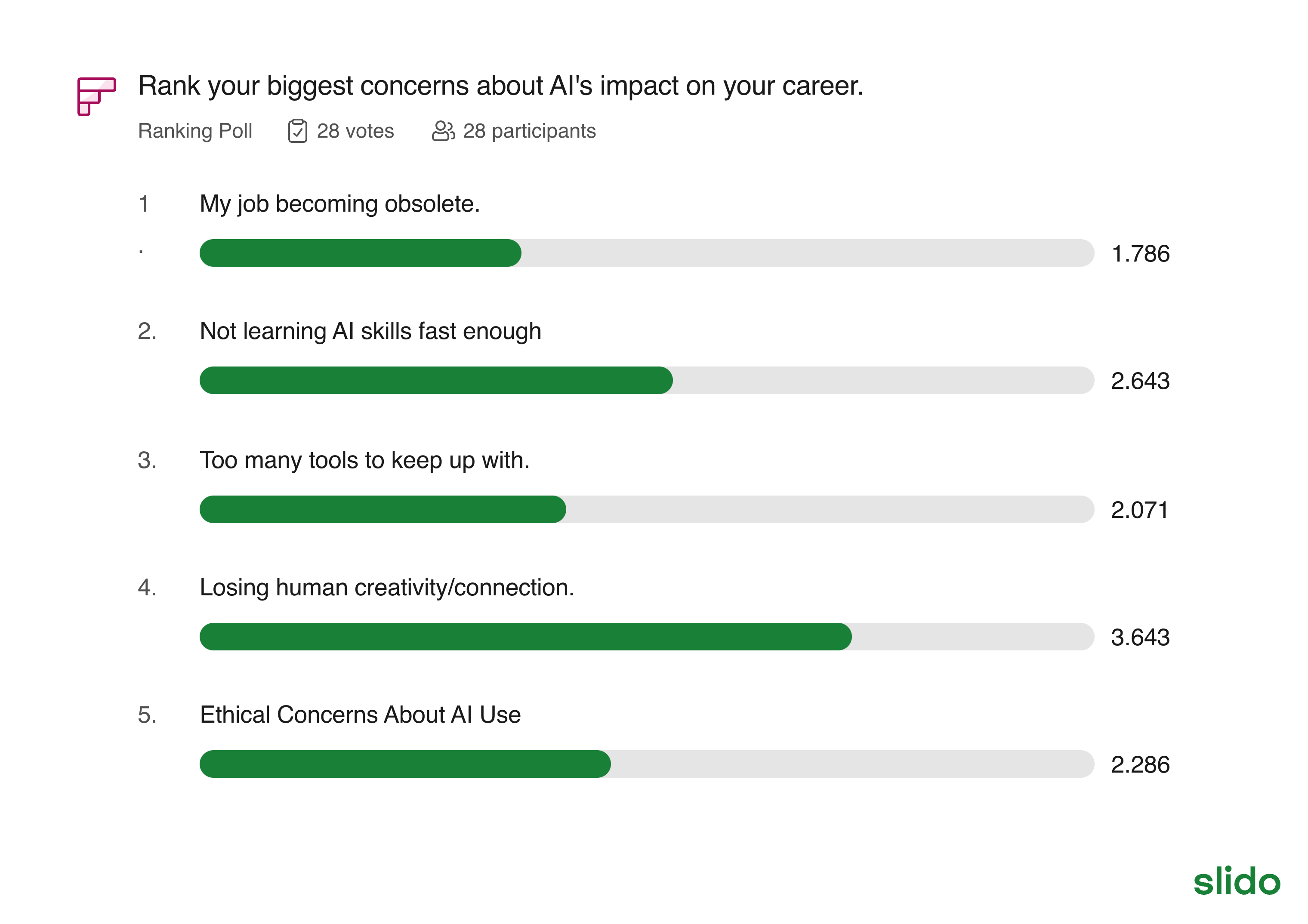
This isn’t naive optimism about job security.
These students revealed something more nuanced—they’re not worried about having jobs, but they’re deeply concerned about what those jobs will look like. Will work still be creative? Will it still involve meaningful human connection?
They recognize that keeping a job isn’t enough if that job loses its human essence.
The emotional journey throughout the lecture supported this insight. The opening word cloud when I asked how generative AI made them feel showed a mix: “curious,” “confused,” “powerful,” “uneasy,” “professional.”
By the end, after discussing real applications and opportunities, the words had shifted: “Opportunity,” “Tool,” “Money,” “Possibilities,” “Innovation.”
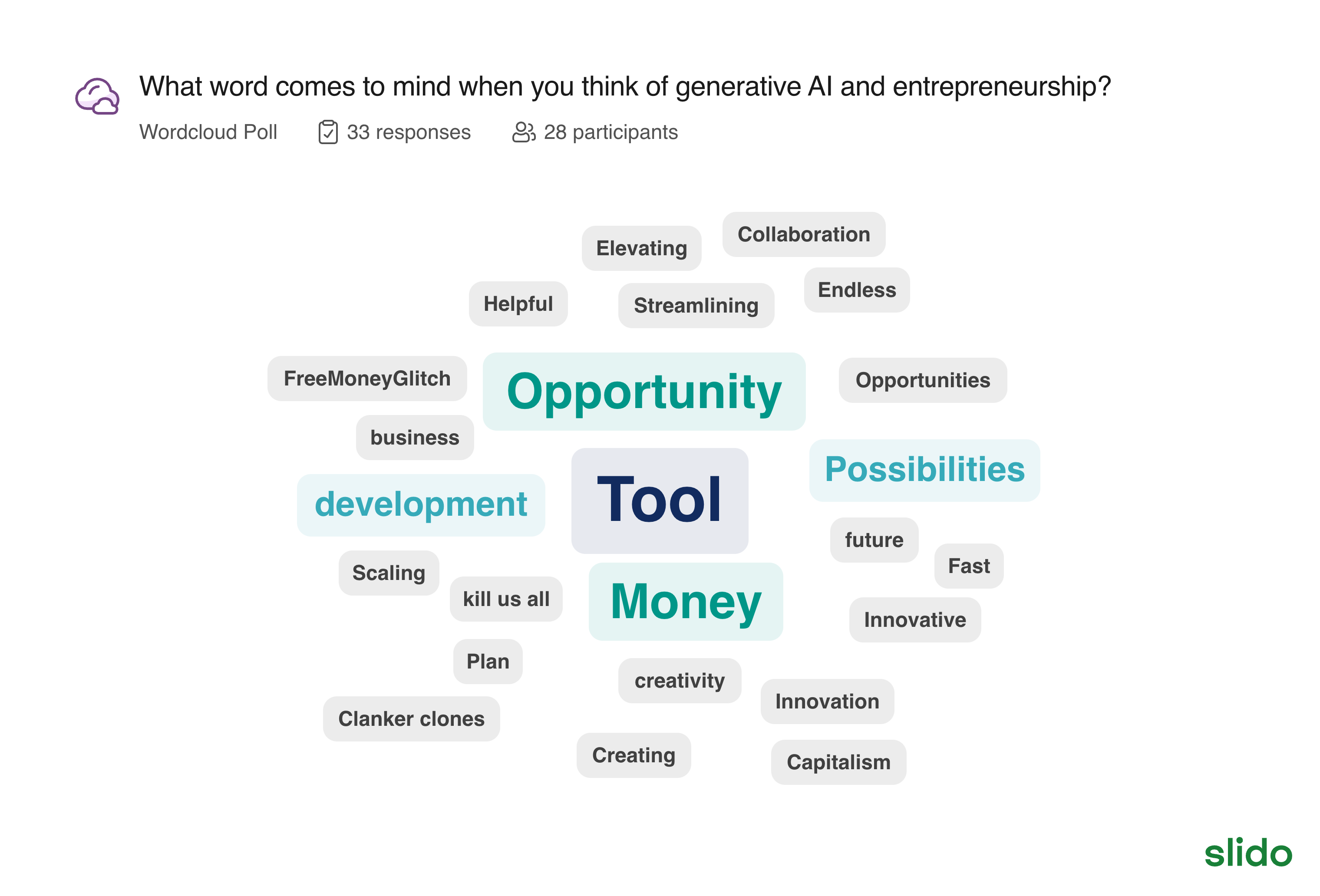
The fear hadn’t disappeared, but it had transformed into something more productive—cautious optimism mixed with determination.
Assumptions vs. Reality: The Hidden AI Opportunity
Midway through the lecture, I threw them a curveball.
“According to Harvard Business Review research in 2025, what is the #1 use case for AI today?” The options included coding assistance, content creation, research and learning, customer support. Most students went with research and learning—a reasonable guess for college students who use AI for homework.
The actual answer? Therapy and companionship.
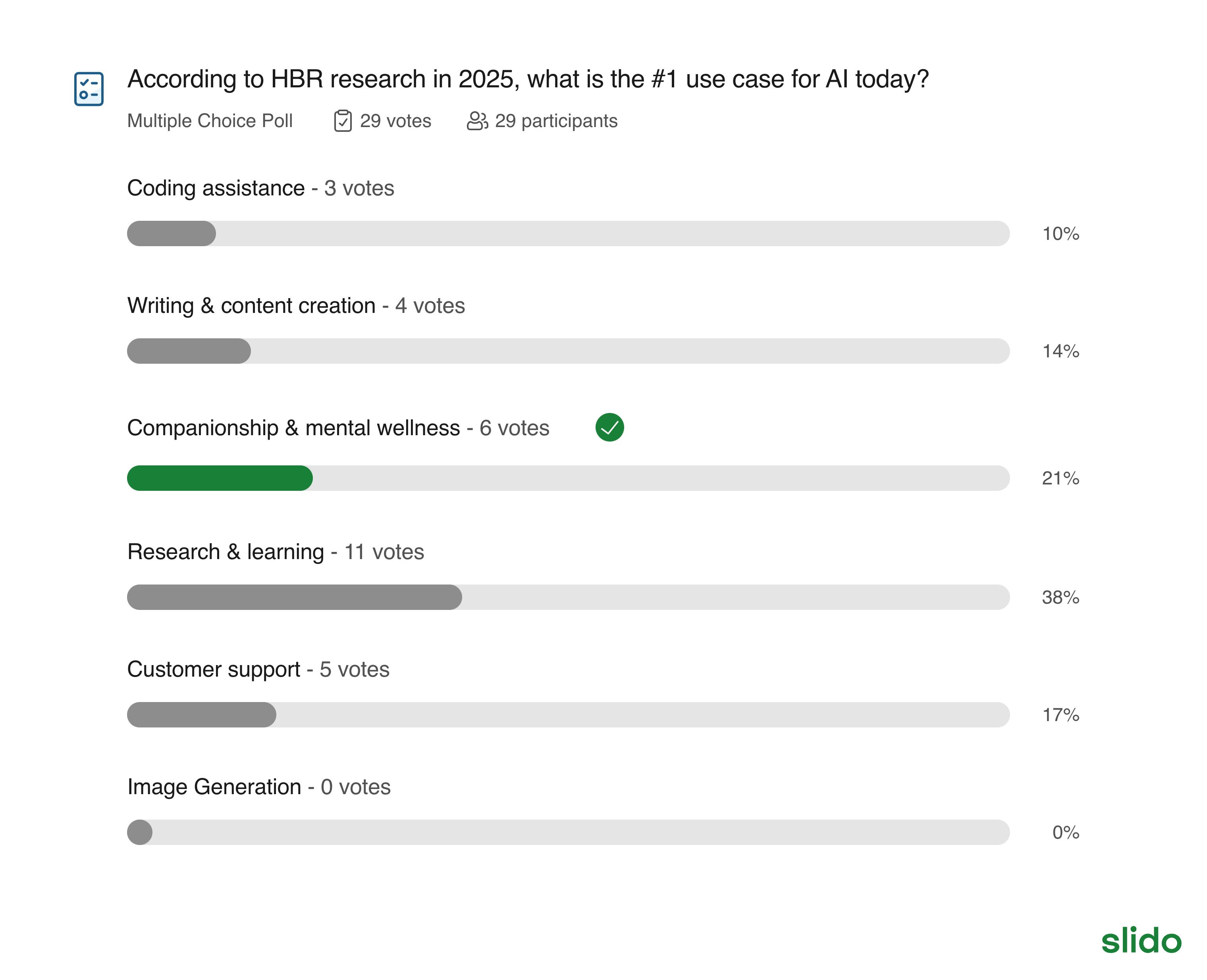
A $10.8 billion market that’s growing at 39% annually. The room went quiet for a moment as they processed this.
This wasn’t about therapy apps specifically—it was about challenging assumptions. Even these AI-savvy students were operating with incomplete information about how AI is actually being used versus how we think it’s being used.
Consumer behavior rarely matches tech industry hype. While we obsess over ChatGPT for homework and Copilot for coding, millions are quietly using AI in completely different ways.
The opportunity here is clear: those who research real AI usage patterns—not just trending tools—will spot markets others miss entirely.
This is what successful entrepreneurs do: they look where others aren’t looking. While everyone rushes to build the next coding assistant, massive opportunities hide in unexpected places.
AI fluency means more than knowing how to prompt ChatGPT. It means understanding how AI is actually being adopted in the real world, who’s using it, and why—then discerning between hype and reality.
Why AI Fluency Matters Now
The venture capital data I shared drove home the urgency: 37% of all VC funding went to AI companies in 2024—an all-time high.
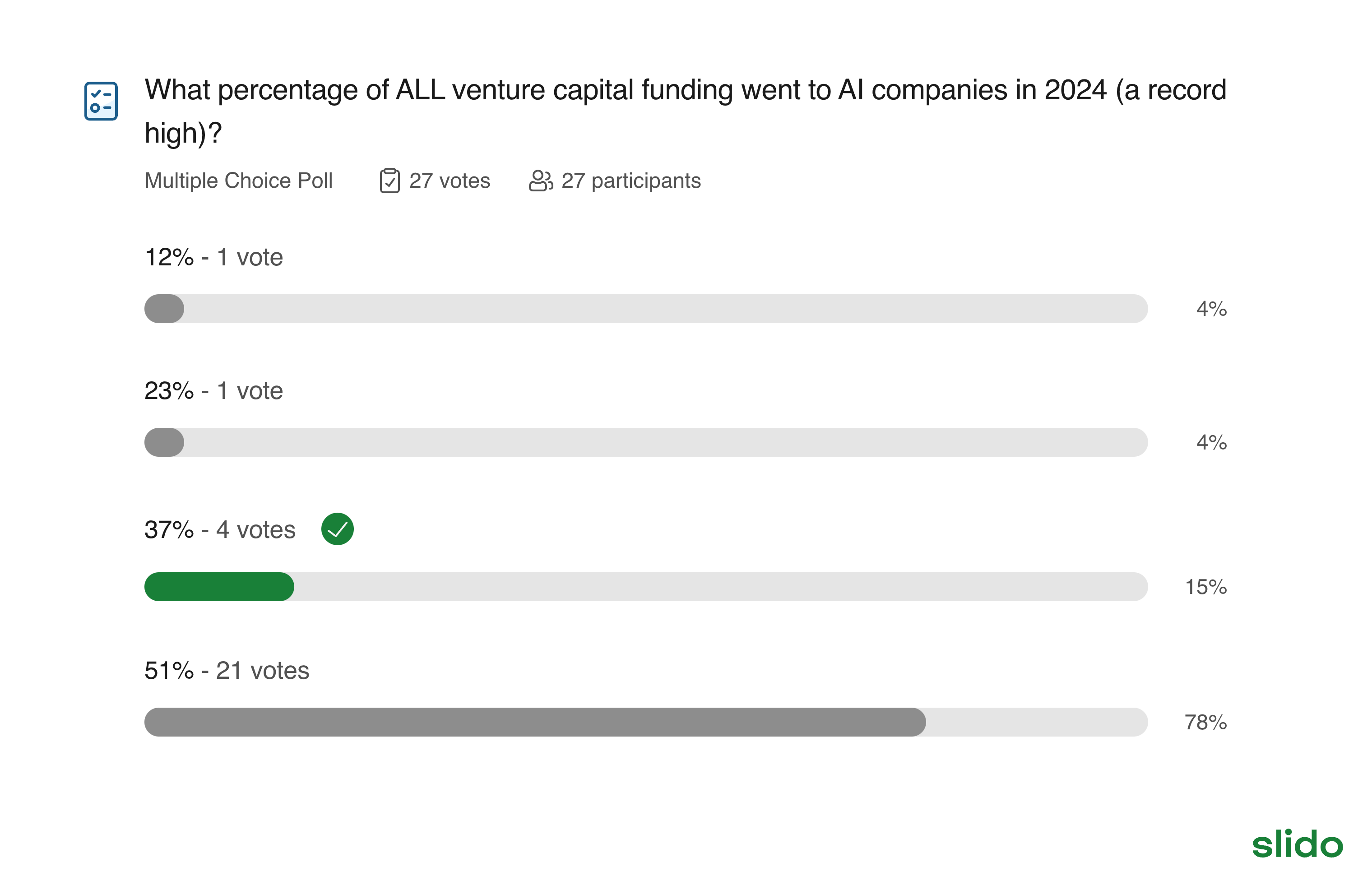
Y Combinator’s portfolio tells an even more dramatic story: from 13% AI companies in 2020 to 67% in 2024.
The message is clear: investors aren’t betting on AI replacing humans—they’re betting on humans who know how to leverage AI.
For these students, AI fluency represents the great equalizer. Traditional advantages—years of experience, established networks, deep industry knowledge—matter less when everyone’s learning new tools. A student who masters AI-powered workflows can compete with someone who has a decade of experience but hasn’t adapted.
But here’s what really matters: the skills that make someone AI-fluent aren’t primarily technical. They’re about communication, critical thinking, and creativity—exactly the human capabilities these students were worried about losing.
The entrepreneurs who will thrive aren’t those who can code; they’re those who can identify problems worth solving and use AI as a tool to solve them faster and better.
Key Takeaways
The students who worried least about job loss might be the ones best prepared for the AI economy—precisely because they understand what really matters.
They’re not asking “Will AI replace me?” They’re asking “How do I stay human while using these powerful tools?”
For educators bringing AI into the classroom, these poll results suggest focusing less on tool tutorials and more on frameworks for thinking about human-AI collaboration. Address the emotional and ethical concerns alongside the technical skills.
For students navigating this landscape, your concerns about creativity and connection aren’t weaknesses—they’re your competitive advantage.
The future belongs to those who can do what AI cannot: build genuine relationships, think creatively across disciplines, and bring human judgment to complex problems.
The Path Forward
Walking out of that lecture hall, I realized these students had taught me as much as I’d taught them.
Their biggest fear wasn’t unemployment—it was dehumanization. And that fear, paradoxically, might be their greatest strength.
The future isn’t human versus AI. It’s human plus AI, with emphasis on the human.
These students already understand this. They’re developing AI fluency not to become more machine-like, but to become more effectively human. They’re learning to use AI as a tool while zealously guarding the creativity and connection that makes their work meaningful.
My advice after this experience? Develop AI fluency—learn the tools, understand the landscape, spot the opportunities.
But double down on what makes you irreplaceably human.
Because if these students are right, that’s what will matter most.